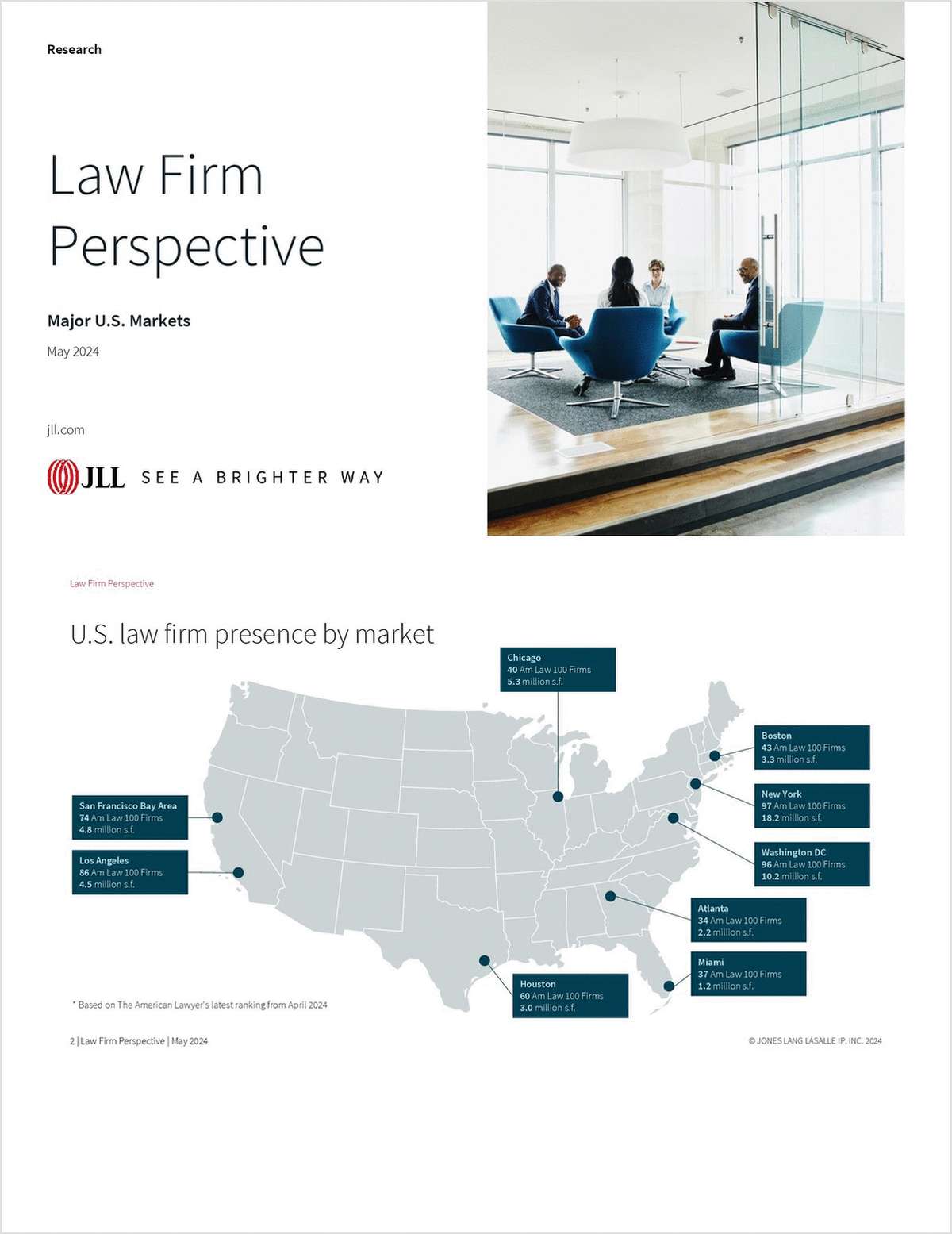 Seattle's downtown skyline.
Seattle's downtown skyline.Firms Find Fertile Ground for Growth in Smaller Markets
Certain Midwest and second-tier markets, in terms of population, have garnered interest from large law firms, especially those that serve middle-market clients.
July 30, 2018 at 06:40 PM
6 minute read
For regional firms looking to go national, setting up shop between the coasts has become a key to growth.
Certain Midwest and second-tier markets, in terms of population, have garnered particular interest from large law firms, especially those that serve middle-market clients.
“Firms like Ballard Spahr and Saul Ewing that once pursued a regional strategy are now going national with mergers in places like Minneapolis and Chicago,” says Eric Seeger, a principal at Altman Weil. Those two firms both recently completed mergers with Midwest law firms within the last year, growing their geographic footprints and their head counts.
The number of lawyers at NLJ 500 firms grew by 100 or more in each of the Washington State, Illinois, Minnesota and Michigan markets, the 2018 statistics showed.
“There are a lot of firms that started out in the secondary, tertiary markets that now have offices in lots of other secondary, tertiary markets,” says Mary K. Young of the Zeughauser Group.
When those firms make entry to a new market, she noted, they often acquire or take from smaller local firms that would not have made it onto the NLJ 500 on their own.
Take Fox Rothschild, for example. The firm added to the NLJ 500 head count in Seattle for 2017 by acquiring 39-lawyer Riddell Williams in May 2017.
“We are always looking at new markets that we think round out the geographic platform that we have now,” Fox Rothschild firmwide managing partner Mark Morris says. The firm also entered Minneapolis just a couple years ago, and recently grew its Chicago presence through a merger. Morris said a specific client or practice area should not be the driver behind geographic expansion in a new city.
“When we're presented opportunities like that, we bet on the fact that the economy in those cities is going to grow, and we will be able to grow our presence there,” he says. “We have to think that market is going to support that office in and of itself.”
Another factor driving growth in these markets, Young says, is that people want to live and work in the cities where they grew up.
Bob Tannous, managing partner of Columbus, Ohio-based regional firm Porter Wright, noted that roots in the area have long been a draw for young lawyers joining his firm. However, he notes, cities such as Columbus are becoming more attractive to young professionals in their own right, thanks to the cost of living there.
“Columbus … is now becoming more of a destination city for students that didn't grow up there,” he says. “For us, it's getting easier to recruit.”
(Porter Wright saw a slight decrease in overall lawyer head count from 2016 to 2017, but nonpartner head count increased by one.)
Smaller Markets
On the 2018 NLJ 500, the state with the smallest number of lawyers was Hawaii, where one NLJ 500 firm, Jackson Lewis, has three lawyers. The firm opened that office in 2015.
Global firm Dentons found its way into the Hawaii market more recently, acquiring 44-lawyer Alston Hunt Floyd & Ing in May, after clients expressed interest in working with the smaller firm.
Certain small markets are also showing growth in their indigenous law firms.
Maine, for instance, appeared to have an influx of NLJ 500 lawyers, as that population grew by more than 45 percent. But it was due to the fact that two local firms—Drummond Woodsum and Preti, Flaherty, Beliveau & Pachios—appeared on the NLJ 500 for the first time in 2018, following growth in total head count. That development also boosted NLJ 500 head count in New Hampshire, where both of those firms have offices.
The lawyer numbers may continue to grow in these smaller locales thanks to client pressures on rates, Young says.
“I don't think we see this so much yet, but someday we may see more of firms having lawyers in low-cost places for efficiency,” she says.
At the same time, David Barnard of Blaqwell Inc. says small firms based in those markets are increasingly looking for merger opportunities.
“Specialization is continuing. … It's no longer possible to do everything. It's just too tough,” he said. So small practices have to choose their strengths and double down there. After doing that, he says, “the lawyers in those towns are combining so they can offer full service to local clients and maintain their livelihood.”
Big Law firms may seize on that from time to time, Barnard says, but they won't make too much of an investment.
“I think we'll see some of those things. And why not? If they can provide a better service than a two- or three-person generalist, and there's enough demand, that's fine,” Barnard says. “But nobody's going to get rich in these small towns.”
Big Markets Stay Interesting
“There are certain markets that everybody always wants to be in,” Young says, pointing to New York, Washington, D.C., and Silicon Valley. Those markets are continuing to grow, she says.
Boston also appears to be growing in popularity, Young says, and it's no secret that Texas has been a hotbed for law firm expansion the last several years. This year alone, four Texas law firms have been acquired by larger shops, according to Altman Weil MergerLine, and three of those Texas firms had 195 or more lawyers.
Chicago also appeared to be a growth area based on NLJ 500 data, with Illinois head count at NLJ 500 firms increasing by 118.
“There's one phenomenon that's going on that the very best talent wants to live in an urban environment and wants to be in Big Law and Big Law is growing in those cities,” Barnard says.
Some of those cities certainly showed growth from 2017 to 2018, in terms of midsize and large law firm presence.
NLJ 500 firms added more than 800 lawyers in New York. They grew by a smaller amount in Massachusetts, which had 57 more NLJ 500 lawyers, and Texas, where there were 47 more. But Washington, D.C., and California each showed a decrease in the number of NLJ 500 lawyers from 2017 to 2018.
Morris says those markets, while competitive, are still attractive to large firms like his.
“For us, the best opportunities for our firm would be in places where we already are,” he says. “That's the best opportunity financially, especially if an office hasn't gotten to a critical mass.”
This content has been archived. It is available through our partners, LexisNexis® and Bloomberg Law.
To view this content, please continue to their sites.
Not a Lexis Subscriber?
Subscribe Now
Not a Bloomberg Law Subscriber?
Subscribe Now
NOT FOR REPRINT
© 2024 ALM Global, LLC, All Rights Reserved. Request academic re-use from www.copyright.com. All other uses, submit a request to [email protected]. For more information visit Asset & Logo Licensing.
You Might Like
View All
Global 200 Firms Gaining Deal Share Amid Race to Build in India

Trending Stories
Who Got The Work
Michael G. Bongiorno, Andrew Scott Dulberg and Elizabeth E. Driscoll from Wilmer Cutler Pickering Hale and Dorr have stepped in to represent Symbotic Inc., an A.I.-enabled technology platform that focuses on increasing supply chain efficiency, and other defendants in a pending shareholder derivative lawsuit. The case, filed Oct. 2 in Massachusetts District Court by the Brown Law Firm on behalf of Stephen Austen, accuses certain officers and directors of misleading investors in regard to Symbotic's potential for margin growth by failing to disclose that the company was not equipped to timely deploy its systems or manage expenses through project delays. The case, assigned to U.S. District Judge Nathaniel M. Gorton, is 1:24-cv-12522, Austen v. Cohen et al.
Who Got The Work
Edmund Polubinski and Marie Killmond of Davis Polk & Wardwell have entered appearances for data platform software development company MongoDB and other defendants in a pending shareholder derivative lawsuit. The action, filed Oct. 7 in New York Southern District Court by the Brown Law Firm, accuses the company's directors and/or officers of falsely expressing confidence in the company’s restructuring of its sales incentive plan and downplaying the severity of decreases in its upfront commitments. The case is 1:24-cv-07594, Roy v. Ittycheria et al.
Who Got The Work
Amy O. Bruchs and Kurt F. Ellison of Michael Best & Friedrich have entered appearances for Epic Systems Corp. in a pending employment discrimination lawsuit. The suit was filed Sept. 7 in Wisconsin Western District Court by Levine Eisberner LLC and Siri & Glimstad on behalf of a project manager who claims that he was wrongfully terminated after applying for a religious exemption to the defendant's COVID-19 vaccine mandate. The case, assigned to U.S. Magistrate Judge Anita Marie Boor, is 3:24-cv-00630, Secker, Nathan v. Epic Systems Corporation.
Who Got The Work
David X. Sullivan, Thomas J. Finn and Gregory A. Hall from McCarter & English have entered appearances for Sunrun Installation Services in a pending civil rights lawsuit. The complaint was filed Sept. 4 in Connecticut District Court by attorney Robert M. Berke on behalf of former employee George Edward Steins, who was arrested and charged with employing an unregistered home improvement salesperson. The complaint alleges that had Sunrun informed the Connecticut Department of Consumer Protection that the plaintiff's employment had ended in 2017 and that he no longer held Sunrun's home improvement contractor license, he would not have been hit with charges, which were dismissed in May 2024. The case, assigned to U.S. District Judge Jeffrey A. Meyer, is 3:24-cv-01423, Steins v. Sunrun, Inc. et al.
Who Got The Work
Greenberg Traurig shareholder Joshua L. Raskin has entered an appearance for boohoo.com UK Ltd. in a pending patent infringement lawsuit. The suit, filed Sept. 3 in Texas Eastern District Court by Rozier Hardt McDonough on behalf of Alto Dynamics, asserts five patents related to an online shopping platform. The case, assigned to U.S. District Judge Rodney Gilstrap, is 2:24-cv-00719, Alto Dynamics, LLC v. boohoo.com UK Limited.
Featured Firms
Law Offices of Gary Martin Hays & Associates, P.C.
(470) 294-1674
Law Offices of Mark E. Salomone
(857) 444-6468
Smith & Hassler
(713) 739-1250












